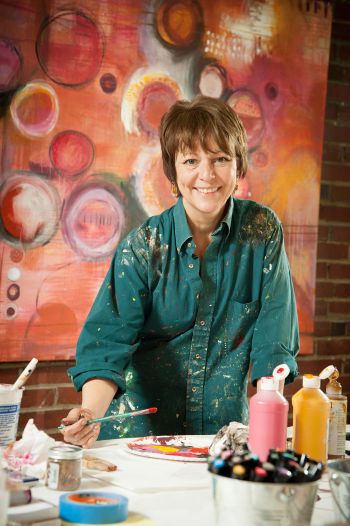Artist Mary Beth Shaw, of Wildwood, Mo., wears any number of professional hats from mixed-media painter to author and nationally recognized workshop instructor. But, she may best be known these days as “StencilGirl” in reference to her role as founder of StencilGirl Products.
Shaw had hand-cut her own stencils for years for use in creating her artwork. She founded StencilGirl Products a stencil design business – in 2010 in order to offer her workshop students and other art hobbyists the opportunity to incorporate high-quality artist-designed stencils in their mixed-media artwork. Four years later, Shaw’s original offering of six stencil designs has grown to more than 600 that are created by a team of 35 professional artists. StencilGirl stencils are laser-cut from Mylar polyester film in sizes ranging from 4-by-4 inches to 9-by-12 inches and are sold worldwide directly to consumers and through arts-and-crafts retail stores.
“Stencils are an accessible artistic tool because you can create a beautiful pattern without having to draw,” said Shaw. “We even offer stencils that you can use to draw a face. By using stencils as a template, you can easily create something pretty.”
 As a mixed-media artist and workshop instructor, Shaw continually experiments to create stenciled artwork with new techniques and media, including decorating Gatorfoam® and Fome-Cor® boards as rigid-substrate pages in a new art journal. Shaw’s art journal-making process is documented in the “StencilGirl Mixed Media Sampler Journal” – a creative workshop on North Light DVD. A follow-up to Shaw’s second book entitled “Stencil Girl Mixed Media for Making and Using Stencils,” this new DVD provides step-by-step instructions for creating five uniquely layered art journal pages and an embellished wooden cover.
As a mixed-media artist and workshop instructor, Shaw continually experiments to create stenciled artwork with new techniques and media, including decorating Gatorfoam® and Fome-Cor® boards as rigid-substrate pages in a new art journal. Shaw’s art journal-making process is documented in the “StencilGirl Mixed Media Sampler Journal” – a creative workshop on North Light DVD. A follow-up to Shaw’s second book entitled “Stencil Girl Mixed Media for Making and Using Stencils,” this new DVD provides step-by-step instructions for creating five uniquely layered art journal pages and an embellished wooden cover.
The journal provides a sort of brag book “to show off your stencil work,” according to Shaw.
White Fome-Cor board in the 3/16-inch thickness was utilized to create two journal pages – one decorated with stencils and PanPastels and the other with paint and dry inclusion techniques that feature stencil designs carved into the Fome-Cor board surface with a stylus. Two additional journal pages were created with white Gatorfoam in the ½-inch thickness – one decorated with stencils and PanPastels and the other featuring stencils in a magazine collage. A fifth page features stencils and alcohol ink on scratchboard. Wooden covers are embellished with wood-burning techniques and metal.
 Shaw cut both the Fome-Cor board and Gatorfoam into 6-by-6-inch square journal pages with a sharp artist’s knife and straight edge. She prepared the surfaces of both the Gatorfoam and Fome-Cor boards with black gesso, including using it to seal the graphic display boards’ exposed foam edges.
Shaw cut both the Fome-Cor board and Gatorfoam into 6-by-6-inch square journal pages with a sharp artist’s knife and straight edge. She prepared the surfaces of both the Gatorfoam and Fome-Cor boards with black gesso, including using it to seal the graphic display boards’ exposed foam edges.
“Fome-Cor board is a really cool substrate; it makes really interesting fun pages in the journal,” said Shaw. “You can do a lot with it that you can’t do with substrates that artists might regularly use – such as paper, wood or clay board. … Fome-Cor offers a slick surface and is very lightweight.”
In one journal page, Shaw chose a fern stencil to carve fern impressions into the Fome-Cor board’s paper surface, followed by paint dropped into the depressed carved areas to create the first layer in this multi-layer piece.
“I would stick to more dry painting techniques with Fome-Cor board and avoid water colors,” said Shaw. “I would apply straight acrylic paints in thin coats. Fome-Cor also works well with rubber stamp inks.”
Shaw chose to incorporate ½-inch Gatorfoam pages in the journal to create pages with a board-book look.
“Gatorfoam is really sturdy and thick,” said Shaw. “It’s cool to create fat board-book looking pages. When you bind the pages together as a book, it creates a really interesting look. Gatorfoam can be used as a stand-alone substrate for other artwork because it doesn’t warp. I like the fact that Gatorfoam is sturdy and rigid but ultra-lightweight compared to wood.”
Shaw selected Gatorfoam to serve as the rigid-substrate base for one journal page that featured a multi-layered magazine-image collage glued down with gel medium and decorated with stencils.
“Gatorfoam is a more robust substrate,” said Shaw. “It can tolerate more layers of mixed media.”
Shaw developed the “StencilGirl Mixed Media Sampler Journal” to encourage art hobbyists to discover new substrates and decorating techniques to use with stencils. In addition to mixed-media artwork, Shaw has used stencils to create everything from embroidery patterns to decorative iced cupcakes.
“Using stencils traditionally suggests using paint,” said Shaw. “I want viewers to think beyond the stencil.”
To view the complete line of StencilGirl stencils, DVDs, books and tutorials, visit www.StencilGirlProducts.com. To learn more about Shaw’s mixed-media paintings and workshops, visit www.mbshaw.com.
PHOTO CREDITS:
Images 1-6 – Photos by Christine Polomsky courtesy of North Light Media
Image 7 – Portrait of Mary Beth Shaw by Greg Barth


